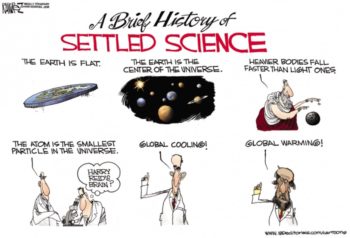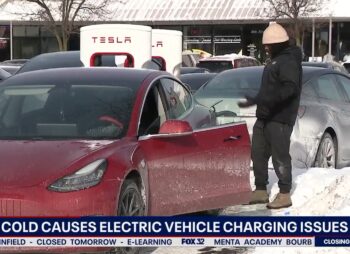
“Silent Spring” blamed pesticides for a host of problems, including the death of birds, and galvanized a movement to scrutinize the air, water, ground, household goods, and food for unnatural contaminants.
Then came the global warming movement, which blazed on the national scene in 1988, when NASA climatologist James Hansen testified before the Senate Energy and Natural Resources Committee that “the greenhouse effect has been detected, and it is changing our climate now.”
Hansen’s testimony gave urgency and credibility to the increasing numbers of environmental activists, the more radical of whom trumpeted the protection of Mother Earth for her own sake, regardless of human benefit.
The Green New Deal signals the ascendancy of a new form of environmentalism––one that elevates socialism as the de facto protector of the natural world. Call it the dictatorship of the greens.
“Eco-socialism” is not new, to be sure. There have been environmentalist socialists since the beginning of the environmental movement. But only recently has the idea attracted national interest.
“Flood Wall Street,” the illegal protest in New York’s financial district the day after the (legal) 2014 People’s Climate March, attracted 3,000 people advocating for the destruction of the U.S. financial system.
Naomi Klein’s 2014 book “This Changes Everything: Capitalism versus the Climate,” which debuted at No. 5 on the New York Times best-seller list, called for the abolition of free markets as the only way to save the planet and usher in a new era of social justice that touches all aspects of life.
The Green New Deal catapults socialism to a new level of visibility. It takes the idea from the fringes of the environmental left to mainstream Democratic policies.
In so doing, it relies heavily on a single word that shows up five times in the 14-page Green New Deal: Sustainability.
Sustainable New Deal?
The Green New Deal, by its own description, collects into one place all the programs it deems necessary “to sustainably meet the challenges of the 21st century.”
It aims to “secure for all people of the United States…a sustainable environment.”
It wants to regulate farms to promote “sustainable farming and land use practices.”
It intends to build “a more sustainable food system” to ensure “universal access to healthy food.”
And it proposes to clean up all hazardous waste and “abandoned sites” in order to “promote economic development and sustainability.”
Sustainability is an ideology in which protecting the environment is inherently wrapped up in protecting society and the economy––protecting not just against pollutants and high temperatures, but against dangers of any kind.
That means padding workers against potential economic downturns with guaranteed income, labor unions, and generous government welfare that picks up the tab for housing, health care, food, and water.
It also means crushing businesses with restrictive regulations or nationalizing them altogether.
The idea of “sustainability” came out of the 1987 Brundtland Report, named for Norway’s three-time socialist Prime Minister Gro Harlem Brundtland, who chaired the United Nations’ Commission on Sustainable Development.
The Brundtland Report defined sustainability as meeting “the needs of the present without compromising the ability of future generations to meet their own needs.”
But Brundtland and her colleagues had no crystal ball. They had no way to determine what exactly future generations might need. They simply indulged utopian willingness to assert what “needs” the government ought to supply.
The report warned of “life-threatening hazards” stemming from “humanity’s inability to fit its activities” to the limits of nature and cited burdensome population growth, the loss of forests, and the use of fossil fuels.
It declared that it was “futile to attempt” to deal with these environmental problems “without a broader perspective” that included “world poverty and international inequality.”
Campus: The Source of the Sustainability Movement
Fast-forward 35 years and sustainability has become a key organizing principle for higher education, as Peter Wood and I documented in “Sustainability: Higher Education’s New Fundamentalism.”
Colleges and universities have rushed to introduce some 458 degree programs in sustainability including sustainability doctorates and sustainability-themed MBAs.
And they have hired some 452 sustainability professionals, according to a 2017 study by the Association for the Advancement of Sustainability in Higher Education. Campus Sustainability Directors earn a median salary of $82,000.
The environment can’t really be separated from our society and the economy, according to the doctrine of sustainability. Hence the common depiction of sustainability as a Venn diagram, showing three interlocking circles labeled “environment,” “society,” and “economy,” with “sustainability” in the middle.
That explains why some have proposed bizarre correlations between environmental and social problems, like this study that estimated global warming would cause an additional 180,000 rapes by 2099.
And a couple years ago National Geographic (among many other publications) credited climate change with the rise of ISIS. (Sen. Bernie Sanders also blamed climate change for terrorism, while Prince Charles pinned it with the war in Syria.)
Via the concept of “environmental racism,” global warming has also been blamed for exacerbating racism and social injustice. (Often this is described as harming “frontlines communities.”)
And the corporations blamed for causing climate change are also blamed for income inequality.
The campus sustainability movement has never stayed on campus. The campus activists Wood and I researched four years ago in “Sustainability” went on to establish professional political organizing machines.
One, the Sunrise Movement, was started by college activists who, after graduation, floated the idea of a Green New Deal, endorsed Rep. Ocasio-Cortez, provided manpower to work her campaign, and organized the sit-in at House Speaker Nancy Pelosi’s office that Ocasio-Cortez famously joined.
At the press release announcing the Green New Deal Resolution, Ocasio-Cortez took a few minutes to speak to Sunrise’s Facebook live stream, saying that: “If Sunrise was not here, and if all of those young people were not sleeping in a church 20 minutes out to come here during orientation, who knows if we would be here right now.”
Sen. Ed Markey, the Green New Deal cosponsor, invited Sunrise co-founder Varshini Prakash as his guest to the State of the Union.
An All-Encompassing Agenda
The Green New Deal opens with a list of social groups it deems of special importance, none of them defined by exposure to environmental pollution: “indigenous communities, communities of color, migrant communities, deindustrialized communities, depopulated rural communities, the poor, low-income workers, women, the elderly, the unhoused, people with disabilities, and youth.”
That is, pretty much everyone except old white men.
Sprinkled throughout the proposals for banning fossil fuels, building electric trains, and investing government money into solar panels are a series of plans whose connection to climate change makes sense only by way of “sustainability.”
There’s a line requiring the United States to provide “high-quality education, including higher education, to all people of the United States,” once again “with a focus on” the “frontline and vulnerable communities.”
One section elevates labor unions to preferential federal treatment. The Green New Deal must “ensure” the creation of “high-quality union jobs” for these new infrastructure projects.
The proposal also says the Green New Deal cannot be accomplished without “strengthening and protecting the right of all workers to organize, unionize, and collectively bargain.”
Then comes the requirement for the government to start “guaranteeing a job with a family-sustaining wage, adequate family and medical leave, paid vacations, and retirement security to all people of the United States.”
And demand for “free, prior, and informed consent of indigenous people for all decisions that affect them,” including “enforcing the sovereignty and land rights” they claim.
The final paragraph of the Green New Deal lays out a list of benefits the government should provide to all people: “high-quality health care; affordable, safe, and adequate housing; economic security” and finally “access to clean water, clean air, healthy and affordable food, and nature.”
The sustainability movement found its first foothold in America on college campuses, but like most social movements in higher education, it hasn’t stayed there. The Green New Deal is the campus sustainability movement grown up and gone to Congress.
Read more at The Federalist

















Brain wash camps for $30,000 per year .
At least in China and Russia you are not paying
you are just imprisoned .
Socialism …the great leveler . Venezuela the recent example of socialism
leveling a country . It’s coming to the USA but they are going to want those guns first . Imagine the civil war with automatic weapons .
There are no more schools anymore their now Indoctrination centers for Big Brother
Well I’ll be! Heaven on Earth!